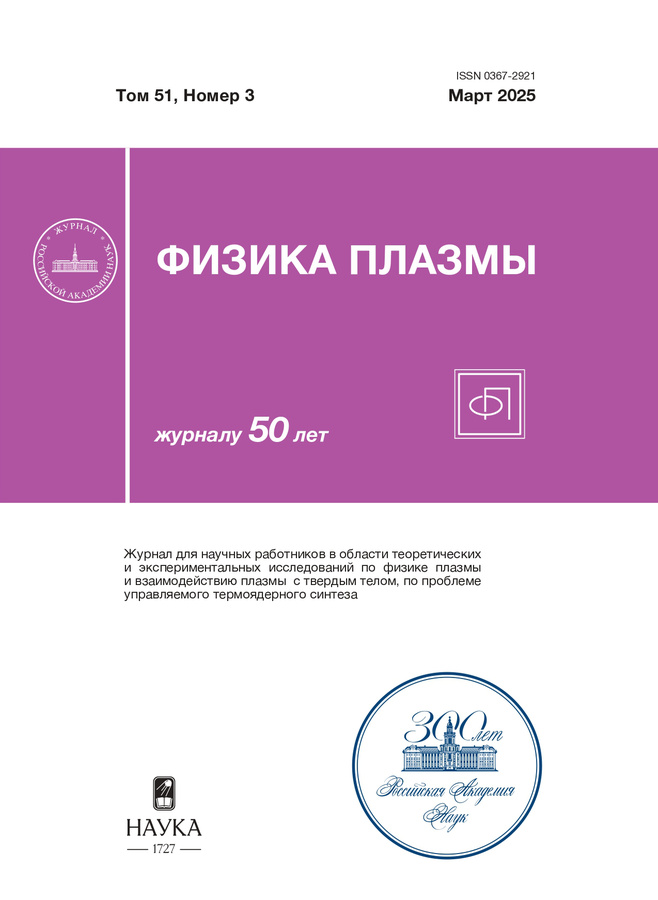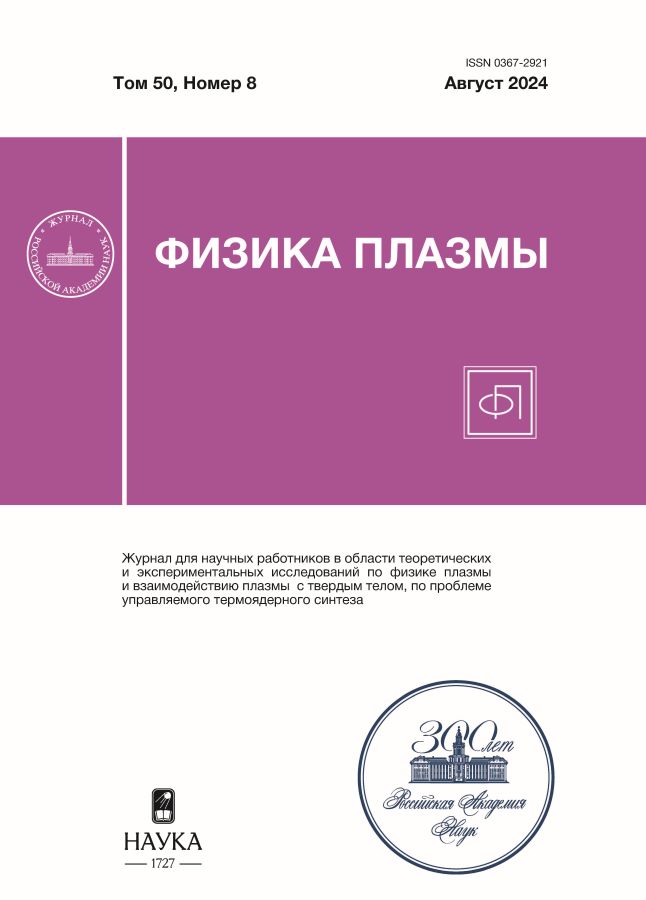Нульмерная модель СВЧ - разряда в воде при барботировании метана через разрядную зону
- Авторы: Лебедев Ю.А.1, Батукаев Т.С.1, Билера И.В.1, Татаринов А.В.1, Титов А.Ю.1, Эпштейн И.Л.1
-
Учреждения:
- Институт нефтехимического синтеза им. А.В. Топчиева РАН
- Выпуск: Том 50, № 8 (2024)
- Страницы: 946-958
- Раздел: НИЗКОТЕМПЕРАТУРНАЯ ПЛАЗМА
- URL: https://permmedjournal.ru/0367-2921/article/view/677462
- DOI: https://doi.org/10.31857/S0367292124080108
- EDN: https://elibrary.ru/NZRWWM
- ID: 677462
Цитировать
Полный текст
Аннотация
В нульмерном приближении проведено моделирование СВЧ-разряда внутри пузырька с метаном в кипящей воде с учетом изменения размера плазменного пузыря. Также проведено моделирование процесса закалки продуктов реакций после отрыва пузыря от поверхности электрода. Рабочее давление – одна атмосфера. Показано, что основными продуктами являются H2, CO2 и CO. Отношение концентраций CO2 и CO зависит от отношения начальных потоков паров воды и метана. Рассчитанные концентрации основных продуктов разложения метана и воды хорошо согласуются с экспериментальными данными.
Ключевые слова
Полный текст
Об авторах
Ю. А. Лебедев
Институт нефтехимического синтеза им. А.В. Топчиева РАН
Автор, ответственный за переписку.
Email: lebedev@ips.ac.ru
Россия, Москва
Т. С. Батукаев
Институт нефтехимического синтеза им. А.В. Топчиева РАН
Email: lebedev@ips.ac.ru
Россия, Москва
И. В. Билера
Институт нефтехимического синтеза им. А.В. Топчиева РАН
Email: lebedev@ips.ac.ru
Россия, Москва
А. В. Татаринов
Институт нефтехимического синтеза им. А.В. Топчиева РАН
Email: lebedev@ips.ac.ru
Россия, Москва
А. Ю. Титов
Институт нефтехимического синтеза им. А.В. Топчиева РАН
Email: lebedev@ips.ac.ru
Россия, Москва
И. Л. Эпштейн
Институт нефтехимического синтеза им. А.В. Топчиева РАН
Email: lebedev@ips.ac.ru
Россия, Москва
Список литературы
- Arutyunov V.S. // Combust. Plasma Chem. 2021. V. 19. P. 245.
- Holladay J.D., Hu J., King D.L., Wang Y. // Catal. Today. 2009. V. 139. P. 244.
- Abbas H.F., Daud W.M.A.W. // Int. J. Hydrogen Energy. 2010. V. 35. P. 1160. https://doi.org/10.1016/ j.ijhydene.2009.11.036
- Dincer I., Acar C. // Int. J. Hydrogen Energy. 2015. V. 40. P. 11094. https://doi.org/10.1016/ j.ijhydene.2014.12.035
- Nikolaidis P., Poullikkas A. // Renew. and Sustain. Energy Rev. 2017. V. 67. P. 597. https://doi.org/10.1016/j.rser.2016.09.044
- Slovetskii D. I. // High Energy Chem. 2006. V. 40. P. 86. https://doi.org/10.1134/S0018143906020044
- Burlica R., Shih K. Y., Hnatiuc B., Locke B. R. // Indust. Engin. Chem. Res. 2011. V. 50. P. 9466. https://doi.org/10.1021/ie101920n
- Mizeraczyk J., Urashima K., Jasiński M., Dors M. // Int. J. Plasma Environ. Sci. Technol. 2014. V. 8. P. 89.
- Mizeraczyk J., Jasiński M. // The European Phys. J. Appl. Phys. 2016. V. 75. P. 24702. https://doi.org/10.1051/epjap/2016150561
- Nedybaliuk O.A., Chernyak V.Y., Fedirchyk I.I., Demchina V.P., Bortyshevsky V.A., Korzh R.V. // Quest. Atomic Sci. Technol. 2016. V. 6. P. 276.
- Lian H.Y., Liu J.L., Li X.S., Zhu X., Weber A.Z., Zhu A.M. // Chem. Engineer. J. 2019. V. 369. P. 245. https://doi.org/10.1016/j.cej.2019.03.069
- Wang B., Lü Y., Zhang X., Hu S. // J. Natural Gas Chem. 2011. V. 20. P. 151. https://doi.org/10.1016/S1003-9953(10)60160-0
- Henriques J., Bundaleska N., Tatarova E., Dias F.M., Ferreira C.M. // Int. J. Hydrogen Energy. 2011. V. 36. P. 345. https://doi.org/10.1016/j.ijhydene.2010.09.101
- Bundaleska N., Tsyganov D., Saavedra R., Tatarova E., Dias F.M., Ferreira C.M. // Int. J. Hydrogen Energy. 2013. V. 38. P 9145. https://doi.org/10.1016/j.ijhydene.2013.05.016
- Wang Y.F., You Y.S., Tsai C.H., Wang L. C. // Int. J. Hydrogen Energy. 2010. V. 35. P. 9637. https://doi.org/10.1016/j.ijhydene.2010.06.104
- Hrycak B., Czylkowski D., Miotk R., Dors M., Jasinski M., Mizeraczyk J. // Open Chem. 2015. V. 13. P. 317. https://doi.org/10.1515/chem-2015-0039
- Miotk R., Hrycak B., Czylkowski D., Dors M., Jasinski M., Mizeraczyk J. // Plasma Sources Sci. Technol. 2016. V. 25. P. 035022. https://doi.org/10.1088/0963-0252/25/3/035022
- Bardos L., Baránková H., Bardos A. // Plasma Chem. Plasma Process. 2017. V. 37. P. 115. https://doi.org/10.1007/s11090-016-9766-6
- Yan J., Du C. Hydrogen Generation from Ethanol Using Plasma Reforming Technology. Hangzhou: Springer, Zhejiang University Press, 2017.
- Bundaleska N., Tsyganov D., Tatarova E., Dias F.M., Ferreira C.M. // Int. J. Hydrogen Energy. 2014. V. 39. P. 5663. https://doi.org/10.1016/j.ijhydene.2014.01.194
- Levko D.S., Tsymbalyuk A.N., Shchedrin A.I. // Plasma Phys. Rep. 2012. V. 38. P. 913. https://doi.org/10.1134/S1063780X1210008X
- Shchedrin A.I., Levko D.S., Chernyak V.Y., Yukhimenko V.V., Naumov V.V. // JETP Lett. 2008. V. 88. P. 99. https://doi.org/10.1134/S0021364008140063
- Wang W., Zhu C., Cao Y. // Int. J. Hydrogen Energy. 2010. V. 35. P. 1951. https://doi.org/10.1016/j.ijhydene.2009.12.170
- Adamovich I., Agarwal S., Ahedo E., Alves L.L., Baalrud S., Babaeva N., Bogaerts A., Bourdon A., Bruggeman P.J., Canal C., Choi E.H., Coulombe S., Zoltan Donkó Z., Graves D.B., Hamaguchi S., Hegemann D., Hori M., Kim H.-H., Kroesen G.M.W., Kushner M.J., Laricchiuta A., Li X., Magin T.E., Mededovic Thagard S., Miller V., Murphy A.B., Oehrlein G.S., Puac N., Sankaran R.M., Samukawa S., Shiratani M., Šimek M., Tarasenko N., Terashima K., Thomas Jr.E., Trieschmann J., Tsik ata S., Turner M.M., Van Der Walt I.J., Van De Sanden M.C.M, von Woedtke T. // J. Phys. D: Appl. Phys. 2022. V. 55. P. 373001. https://doi.org/10.1088/1361-6463/ac5e1c
- Malik M.A., Ghaffar A., Malik S.A. // Plasma Sources Sci. Technol. 2001. V. 10. P. 82. https://doi.org/10.1088/0963-0252/10/1/311
- Foster J.E. // Phys. Plasmas. 2017. V. 24. P. 055501. https://doi.org/10.1063/1.4977921
- Rezaei F., Vanraes P., Nikiforov A., Morent R., Geyter N. // Materials. 2019. V. 12. P. 2751. https://doi.org/10.3390/ma12172751
- Locke B.R. // Int. J. Plasma Environ. Sci. Technol. 2012. V. 6. P. 194.
- Rybkin V.V., Shutov D.A. // Plasma Phys. Rep. 2017. V. 43. P. 1089.
- Vanraes P., Bogaerts A. // Appl. Phys. Rev. 2018. V. 5. P. 031103. https://doi.org/10.1063/1.5020511
- Lebedev Yu.A. // Plasma Phys. Rep. 2017. V. 43. P. 676. https://doi.org/10.1134/S1063780X17060101
- Horikoshi S., Serpone N. // RSC Adv. 2017. V. 7. P. 47196.
- Lebedev Yu.A. // High Temp. 2018. V. 56. P. 811. https://doi.org/10.1134/ S0018151X18050280
- Lebedev Yu.A. // Polymers. 2021. V. 13. P. 1678. https://doi.org/10.3390/polym13111678
- Nomura S., Toyota H., Mukasa S., Yamashita H., Maehara T., Kawashima A. J. // J. Appl. Phys. 2009. V. 106. P. 073306. https://doi.org/10.1063/1.3236575
- Nomura S., Toyota H., Tawara M., Yamashota H. // Appl. Phys. Lett. 2006. V. 88. P. 231502. https://doi.org/10.1063/1.2210448
- Liu J.L., Zhu T.H., Sun B. // Int. J. Hydrogen Energy. 2022. V. 47. P. 12841.https://doi.org/10.1016/j.ijhydene.2022.02.041
- Sun B., Zhao X., Xin Y., Zhu X. // Int. J. Hydrogen Energy. 2017. V. 42. P. 24047. https://doi.org/10.1016/j.ijhydene.2017.08.052
- Lebedev Yu.A., Tatarinov A.V., Epshtein I.L., Titov A.Y. // High Energy Chem. 2022. V. 56. P. 448. https://doi.org/10.1134/S001814392206011X
- Batukaev Т.S., Bilera I.V., Krashevskaya G.V., Lebedev Yu.A., Epstein I.L. // Plasma Proc. Polym. 2023. V. 20. P. e2300015. https://doi.org/10.1002/ppap.202300015
- B atukaev Т.S., Bilera I.V., Krashevskaya G.V., Lebedev Yu.A. // Processes. 2023. V. 11. P. 2292. https://doi.org/10.3390/pr11082292
- Wang Q., Wang J., Zhu T., Zhu X., B. Sun B. // Int. J. Hydrogen Energy. 2021. V. 46. P. 34105.
- Wang Q., Wang J., Sun J., Sun S., Zhu X., Sun B. // Chemical Engineer. J. 2023. V. 465. P. 142872.
- Wang Q., Sun S., Yang Y., Zhu X., Sun B. // Energy. 2024. V. 289. P. 130023.
- Сердюков В.С. Экспериментальное исследование микрохарактеристик и теплообмена при кипении жидкостей в условиях различных давлений: Дис. … канд. физ.-матем. наук. Новосибирск, 2020.
- Hagelaar G., Pitchford L. // Plasma Sources Sci. Technol. 2005. V. 14. P. 722.
- Triniti Database. www.lxcat.net. Retrieved on May, 2024.
- Janev R.K., Reiter D. // Phys. Plasmas. 2002. V. 9. P. 4071.
- Morgan Database. www.lxcat.net. Retrieved on May, 30, 2024.
- Janev R.K., Reiter D. // Phys. Plasmas. 2004. V. 11. P. 780.
- Avtaeva S., General A., Kel’man V. // J. Phys. D: Applied Phys. 2010. V. 43. P. 315201.
- Aoki H., Kitano K., Hamaguchi S. // Plasma Sources Sci. Technol. 2008. V. 17. P. 025006.
- Pancheshnyi S., Biagi S., Bordage M., Hagelaar G., Morgan W., Phelps A., Pitchford L. // Chem. Phys. 2012. V. 398. P. 148.
- Rehman F., Lozano-Parada J.H., Zimmerman W.B. // Int. J. Hydrogen Energy. 2012. V. 37. P. 17678.
- Wang W., Snoeckx R., Zhang X., Cha M., Bog aerts A.J. // Phys. Chem. C. 2018. V. 122. P. 8704
- Tsyganov D., Bundaleska N., Tatarova E., Dias A., Henriques J., Rego A., Ferraria A., Abrashev M.V., Dias F.M.M., Luhrs C.C., Phillips J. // Plasma Sources Sci. Technol. 2016. V.2 5. P. 015013.
- Райзер Ю.П. Физика газового разряда, М.: Наука, 1992.
- GRI-Mech 3.0 http://combustion.berkeley.edu/gri-mech/
- COMSOL Multiphysics. https://comsol.com/chemicalreactionengineering
- Пархоменко В.Д., Полак Л.С., Сорока П.И., Цыбулев П.Н., Мельников Б.И., Гуськов А.Ф. Процессы и аппараты плазмохимической технологии. Киев: Вища школа, 1979.
Дополнительные файлы























